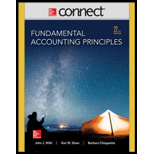
Concept explainers
Concept Introduction:
Variable cost and fixed costs:
Variable costs: The variable costs can be defined as the cost that change directly with the change in the level of output. They are directly related with the level of output. These costs are termed relevant costs as well.
Fixed costs: The fixed costs can be defined as the cost that do not change directly with the change in the level of output. They are not related with the level of output. These costs are termed irrelevant costs generally.
To compute:
The expected −
- Variable cost
- Fixed cost
Answer to Problem 15E
Solution:
The expected −
- Variable cost for the expected units to be sold next year = $ 12,000,000
- Fixed cost for the expected units to be sold next year = $ 3,750,000
Explanation of Solution
The expected variable costs and fixed costs are calculated as under −
- Variable cost for the expected units to be sold next year -
- The expected total sales revenue = $ 17,000,000
- Expected units to be sold = 200,000 units
- Contribution margin per unit = $ 25 per unit
- Expected Pre-tax income for the next year = $ 1,250,000
The expected sales price per unit = $ 85.
Now, variable cost per unit will be calculated as under −
The total expected variable costs are calculated as under −
The total expected variable costs = $ 12,000,000.
2 Fixed cost for the expected units to be sold next year −
The total expected fixed costs will be calculated as under −
Given,
- Expected units to be sold = 200,000 units
- Contribution margin per unit = $ 25 per unit
- Expected Pre-tax income for the next year = $ 1,250,000
- Total expected variable costs = $ 12,000,000
Now, fixed costs will be calculated as −
The expected fixed costs for the next year = $ 3,750,000
Thus, the expected fixed costs and expected variable costs have been calculated for the next year.
Want to see more full solutions like this?
Chapter 21 Solutions
FUND.ACCT.PRIN -ONLINE ONLY >I<
- I need help with this general accounting question using the proper accounting approach.arrow_forward1 1. Provide BOTH the Direct and Indirect cash flow from operations 2. 3. 4. 5. 6. 7. There is no Foreign Exchange Effect. You do not need to provide a line item for that. I will NOT provide Balance Sheet information. This means you will NOT be able to prove out the Net Change in Cash nor the Closing Balance for the sum of Cash, Cash Equivalents and Restricted Cash. There is no Restricted Cash. So if you prefer to show the Opening and Closing balances as the sum of Cash and Cash Equivalents and not refer to Restricted Cash that is fine and even preferred. Be sure to provide a section for Disclosures. Those disclosures must refer to the Indirect Method you are asked to prepare in item #1 above. BE SURE TO PUT YOUR NAME ON YOUR EXCEL SPREADSHEET SO I KNOW WHO TO AWARD THE GRADE TO. GOOD LUCK! The company began the year with a credit balance in Trade Accounts Payable to inventory vendors of $ 300,000. During the year, vendors were paid $ 500,000. The vendors delivered $ 800,000 in…arrow_forwardCan you explain this general accounting question using accurate calculation methods?arrow_forward

 AccountingAccountingISBN:9781337272094Author:WARREN, Carl S., Reeve, James M., Duchac, Jonathan E.Publisher:Cengage Learning,
AccountingAccountingISBN:9781337272094Author:WARREN, Carl S., Reeve, James M., Duchac, Jonathan E.Publisher:Cengage Learning, Accounting Information SystemsAccountingISBN:9781337619202Author:Hall, James A.Publisher:Cengage Learning,
Accounting Information SystemsAccountingISBN:9781337619202Author:Hall, James A.Publisher:Cengage Learning, Horngren's Cost Accounting: A Managerial Emphasis...AccountingISBN:9780134475585Author:Srikant M. Datar, Madhav V. RajanPublisher:PEARSON
Horngren's Cost Accounting: A Managerial Emphasis...AccountingISBN:9780134475585Author:Srikant M. Datar, Madhav V. RajanPublisher:PEARSON Intermediate AccountingAccountingISBN:9781259722660Author:J. David Spiceland, Mark W. Nelson, Wayne M ThomasPublisher:McGraw-Hill Education
Intermediate AccountingAccountingISBN:9781259722660Author:J. David Spiceland, Mark W. Nelson, Wayne M ThomasPublisher:McGraw-Hill Education Financial and Managerial AccountingAccountingISBN:9781259726705Author:John J Wild, Ken W. Shaw, Barbara Chiappetta Fundamental Accounting PrinciplesPublisher:McGraw-Hill Education
Financial and Managerial AccountingAccountingISBN:9781259726705Author:John J Wild, Ken W. Shaw, Barbara Chiappetta Fundamental Accounting PrinciplesPublisher:McGraw-Hill Education





